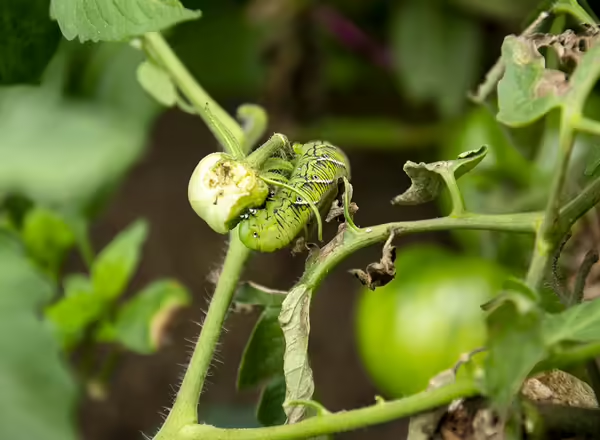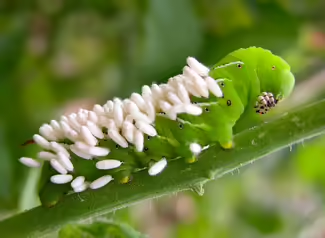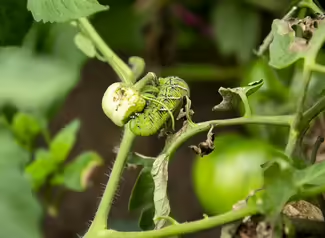Hornworms are the larvae/caterpillars of hawk- or hummingbird-like moths. They are large, up to 4 inches long, green, white-barred worms with a slender horn pointing upward at the rear end.
- The tobacco hornworm (Manduca sexta) is also known as the Carolina sphinx moth.
- Tobacco hornworm caterpillars are generally green with seven diagonal white lines on their sides and have a curved red horn.
- The tomato hornworm (Manduca quinquemaculata) is known as the five-spotted hawkmoth.
- Tomato hornworm caterpillars have eight V-shaped marks on each side, and their horns are straighter and blue-black in color.
The tobacco hornworm is the more commonly seen of the two.

Only the larvae feed on tomato plants. They can consume large quantities of foliage, and 1 to 2 worms can defoliate a five-foot tomato plant in less than three days. They feed on both leaves and fruits.
They are often difficult to find because their color blends in or camouflages with tomato foliage background. Often, they remain undetected until considerable feeding has occurred. If left unchecked, they may destroy the plant. Another indication hornworms are present is the accumulation of their large, black droppings (frass) on plants and the ground.
In addition to tomatoes, hornworms may also feed on eggplant, potatoes, and peppers.
Hornworms overwinter as pupae in the soil. The adult moths emerge in mid to late spring. After mating, females lay small, pearl-like eggs individually on tomato foliage and leaves of other hosts (pepper, potato, eggplant, and some weeds of the nightshade family). The caterpillars hatch and usually pass through five larval stages (instars) in about one month. Fully grown larvae will drop from plants and pupate in the soil. There are typically two generations each summer, and larvae of the second generation will overwinter as pupae.
- Hand-picking the worms in home gardens often provides satisfactory control.
- Since the caterpillars are often well hidden during the day, some people will search for them at night with the help of a UV (black) light. When doing this, the tomato foliage will look deep red/orange, and the caterpillars bright green.
- Rototilling soil after the growing season has finished can also be an effective management strategy. Tilling has been shown to destroy up to 90% of overwintering pupa.

- This wasp places its eggs under the skin of the hornworm.
- When the wasp larvae hatch, they feed internally and pupate.
- The pupae appear as small white cocoons on the back of the hornworm.
- If hornworm larvae are infested with wasp cocoons, the hornworms will stop feeding and their parasitized bodies can serve as a source for increasing the beneficial wasp population.
Pesticides can also be used to manage these pests; make sure to read and follow all label directions. Younger, smaller caterpillars are easier to manage than older, larger individuals.
Contact your county Extension office for current pesticide controls.

